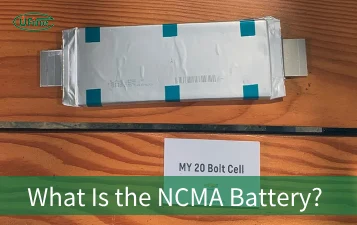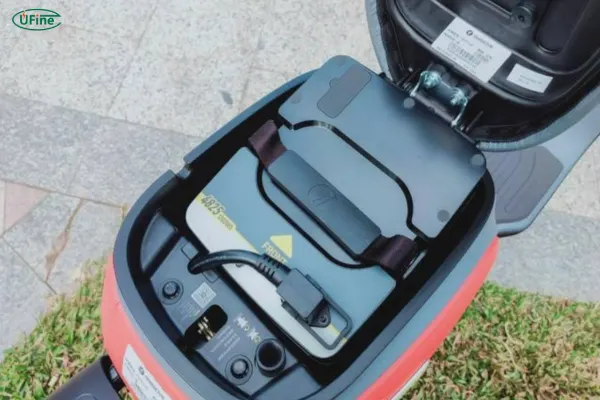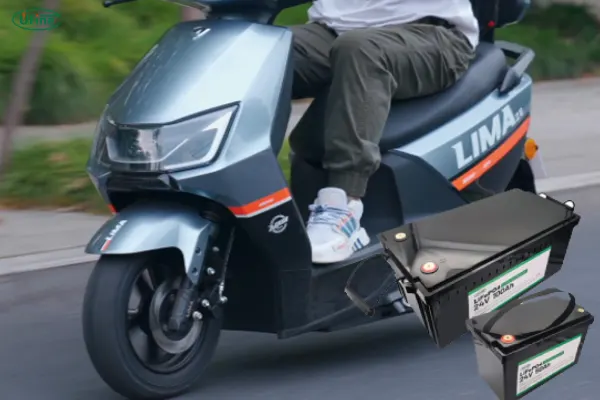
- Part 1. What battery does an electric scooter need?
- Part 2. LFP battery vs. other batteries: which is better for scooters?
- Part 3. LFP Battery for electric scooters: pros and cons
- Part 4. Key parameters for LFP battery electric scooters
- Part 5. How long will an LFP battery last in an electric scooter?
- Part 6. Choosing the right charger for your LFP battery
- Part 7. Custom LFP battery packs for your electric scooter
- Part 8. FAQs
Part 1. What battery does an electric scooter need?
Electric scooters require batteries that balance high energy density, safety, longevity, and fast charging capabilities. Traditionally, Lithium-ion (Li-ion) batteries have been widely used due to their high energy output and lightweight properties. However, with the growing demand for sustainable energy solutions, many electric scooter manufacturers and enthusiasts are shifting towards LiFePO4 (LFP) batteries for enhanced performance and safety.
Part 2. LFP battery vs. other batteries: which is better for scooters?
When it comes to choosing the best battery for your electric scooter, you are faced with several options: LFP batteries, Li-ion batteries, and Nickel Metal Hydride (NiMH) batteries. Each battery type has its unique characteristics, and the decision ultimately depends on your priorities — whether it’s safety, performance, cost, or longevity.
1. Safety
-
LFP Battery: One of the standout features of LFP batteries is their superior safety profile. Due to the stable chemical structure of lithium iron phosphate, these batteries are less prone to thermal runaway — a process that can cause fires or explosions in poorly managed or damaged batteries. This makes LFP batteries one of the safest options for electric scooters, especially for those in regions with higher temperatures.
-
Li-ion Batteries: Lithium-ion (Li-ion) batteries are generally safe, but they have a higher risk of thermal runaway compared to LFP batteries, particularly in the event of overcharging, physical damage, or manufacturing defects. Despite improvements in Battery Management Systems (BMS), Li-ion batteries still present a risk of fire hazards when not managed correctly.
-
NiMH Batteries: Nickel Metal Hydride (NiMH) batteries are relatively safe but have a lower energy density than LFP and Li-ion batteries. They also suffer from a phenomenon known as the memory effect, where they lose their ability to charge fully if they are not discharged completely before being recharged.
Winner: LFP Battery (for superior safety).
2. Energy Density and Range
-
LFP Battery: While LFP batteries are known for their long lifespan and safety, they have a lower energy density compared to Li-ion batteries. This means they tend to be bulkier and heavier for the same capacity. Therefore, scooters with LFP batteries may offer slightly shorter ranges — typically ranging from 30-60 miles on a full charge, depending on the battery size and scooter design.
-
Li-ion Batteries: Li-ion batteries have higher energy density, allowing them to store more power in a smaller and lighter package. This translates to longer ranges for electric scooters. A Li-ion battery-equipped scooter can easily travel 50-80 miles or more on a full charge.
-
NiMH Batteries: While NiMH batteries are relatively inexpensive and widely used in earlier models of electric scooters, they have much lower energy density than both LFP and Li-ion batteries. A typical NiMH battery may only offer a range of around 15-30 miles per charge.
Winner: Li-ion Battery (for longer range and compact design).
3. Lifespan and Durability
-
LFP Battery: LFP batteries are renowned for their exceptionally long lifespan. They can typically endure 3,000 to 5,000 charge cycles, significantly outlasting most other battery types. This means that LFP batteries will continue to perform well for 8-10 years under normal usage, making them an excellent investment for long-term use.
-
Li-ion Batteries: Li-ion batteries have a good lifespan as well, usually lasting between 1,000 to 2,500 cycles. However, the lifespan depends on charging habits and storage conditions, with heat being a major factor that reduces their longevity.
-
NiMH Batteries: NiMH batteries have the shortest lifespan of the three, typically lasting only around 500 to 1,000 charge cycles before noticeable degradation occurs.
Winner: LFP Battery (for the longest lifespan and durability).
4. Cost
-
LFP Battery: LFP batteries are generally cheaper than Li-ion batteries due to the lower cost of raw materials like iron and phosphate. However, their lower energy density means that for a comparable energy output, LFP batteries tend to be bulkier and heavier. As a result, while the initial investment may be lower, the cost per unit of energy stored is typically higher than Li-ion batteries.
-
Li-ion Batteries: Li-ion batteries are more expensive than LFP batteries because of the higher cost of cobalt, nickel, and manganese. However, their higher energy density and compact design can justify the extra cost, especially for users looking for maximum range and performance.
-
NiMH Batteries: NiMH batteries are usually the cheapest option among the three but are also the least efficient in terms of energy density. They have a lower energy output, and with the increased size needed to match the performance of a Li-ion or LFP battery, they are less cost-effective for long-range scooters.
Winner: NiMH Battery (for the lowest upfront cost).
5. Performance in Extreme Temperatures
-
LFP Battery: LFP batteries perform well in high temperatures and are more resistant to temperature fluctuations compared to Li-ion batteries. However, cold weather can reduce their efficiency, although this issue can be mitigated with a Battery Management System (BMS) and proper insulation.
-
Li-ion Batteries: Li-ion batteries are sensitive to extreme temperatures. They perform well in mild conditions but can suffer from reduced performance or permanent damage in very hot or cold temperatures.
-
NiMH Batteries: NiMH batteries are also affected by temperature extremes but tend to be more resilient to cold weather than Li-ion batteries.
Winner: LFP Battery (for better heat resistance and more stable performance in varying conditions).
6. Environmental Impact
-
LFP Battery: LFP batteries are more environmentally friendly than Li-ion batteries because they do not use harmful materials like cobalt and nickel. The manufacturing process is cleaner, and LFP batteries are easier to recycle compared to other lithium-based batteries.
-
Li-ion Batteries: Li-ion batteries use cobalt and nickel, which are not only expensive but also associated with environmental issues related to mining and extraction processes.
-
NiMH Batteries: NiMH batteries are less toxic than Li-ion batteries but still involve heavy metals like nickel in the production process. They are more environmentally friendly than Li-ion but less so than LFP.
Winner: LFP Battery (for environmental sustainability).
Which Battery is Best for Electric Scooters?
-
If your priority is safety, longevity, and environmental sustainability, LFP batteries are the best choice for your electric scooter. Although they may have lower energy density and offer a slightly shorter range compared to Li-ion, their long cycle life, robust thermal stability, and lower cost make them ideal for everyday riders and long-term use.
-
If range, compactness, and high performance are your primary concerns, Li-ion batteries are the go-to option. However, they come at a higher price and may present safety and longevity challenges over time.
-
NiMH batteries should only be considered if cost is the most important factor. They have a shorter lifespan and lower performance, but they still offer a budget-friendly option for basic electric scooters.
Part 3. LFP Battery for electric scooters: pros and cons
The adoption of LFP batteries in electric scooters is gaining traction due to their distinct advantages. However, like all technologies, they come with their own set of limitations.
Pros of LFP Batteries in Electric Scooters:
- Safety: LFP batteries are safer than traditional Li-ion batteries due to their stable chemical structure. They are less prone to thermal runaway, reducing the risk of fires or explosions.
- Longer Lifespan: LFP batteries are known for their long cycle life. They can endure 3,000 to 5,000 charge cycles, meaning they will last significantly longer than typical Li-ion batteries.
- Better Performance in High Temperatures: LFP batteries have superior thermal stability, making them ideal for scooters used in hot climates or high-performance models that need to handle prolonged high power usage.
- Environmental Friendliness: Unlike some other lithium-based batteries, LFP batteries are free from toxic metals like cobalt and nickel, making them more environmentally sustainable.
- Cost-Efficient: LFP batteries tend to be less expensive than NCM (Nickel Cobalt Manganese) and NCA (Nickel Cobalt Aluminum) lithium-ion batteries due to the lower cost of iron and phosphate.
Cons of LFP Batteries in Electric Scooters:
- Lower Energy Density: LFP batteries typically have lower energy density than other lithium-ion variants, meaning they store less energy per unit of weight. As a result, scooters with LFP batteries may have a slightly shorter range compared to Li-ion models.
- Charging Speed: While LFP batteries are relatively efficient, they do not charge as quickly as NCM or NCA batteries.
- Cold Weather Performance: LFP batteries are not as efficient in extremely cold conditions, though their battery management systems (BMS) help mitigate this issue.
Part 4. Key parameters for LFP battery electric scooters
When choosing an LFP battery for your electric scooter, there are several key parameters to consider to ensure optimal performance:
- Voltage (V): Most electric scooters use 36V or 48V systems, but custom configurations can also be created based on the scooter’s design and performance requirements. Ufine Battery can provide tailored voltage configurations to meet specific needs.
- Capacity (Ah): Battery capacity, measured in amp-hours (Ah), determines how much energy the battery can store. A higher Ah rating provides longer range and more power for the scooter.
- Power (W): Power output, measured in watts, indicates the motor’s efficiency. For electric scooters, power ratings typically range from 250W to 2000W, depending on usage.
- Energy Density: LFP batteries tend to have lower energy density compared to other lithium-ion batteries, typically ranging from 90 to 160 Wh/kg.
- Cycle Life: One of the most significant advantages of LFP batteries is their long cycle life, often reaching 3,000 to 5,000 cycles before they degrade significantly.
- Charging Time: LFP batteries tend to have a slightly longer charging time, but they are more efficient in terms of discharge cycles.
Part 5. How long will an LFP battery last in an electric scooter?
The lifespan of an LFP battery in an electric scooter depends on several factors, including how often you charge the scooter, the type of terrain you ride on, and how well you maintain the battery. However, LFP batteries generally have a longer lifespan than other lithium batteries, with the average cycle life being between 3,000 and 5,000 cycles.
For reference, if you use your electric scooter daily and charge it once a day, an LFP battery could last for 6-10 years, making it an excellent long-term investment. The longevity also depends on how you store and maintain your battery — avoiding deep discharges and extreme temperatures can further extend its useful life.
Part 6. Choosing the right charger for your LFP battery
When selecting a charger for your electric scooter with an LFP battery, it’s crucial to ensure that the charger is designed for LFP chemistry. Using the wrong charger can reduce the lifespan of your battery or lead to safety issues.
Key considerations include:
- Voltage Compatibility: Make sure the charger matches your scooter’s voltage system (e.g., 36V or 48V).
- Amperage: The charger should have the appropriate current output for your battery’s capacity. For instance, a 5A charger is typically used for a 48V 20Ah battery to ensure efficient charging without overloading the system.
- Smart Charger: A smart charger with a built-in Battery Management System (BMS) is ideal, as it helps regulate the charging cycle and prevents overcharging.
Part 7. Custom LFP battery packs for your electric scooter
If you require a custom LFP battery pack for your electric scooter, Ufine Battery offers a wide range of customized lithium iron phosphate battery solutions. Whether you need a specific voltage (e.g., 36V, 48V, or 72V), capacity (e.g., 20Ah to 100Ah), or a custom form factor, Ufine Battery can tailor solutions to match your scooter’s requirements.
Our engineering team can design, test, and manufacture a custom battery pack with the optimal parameters for your usage — whether it’s for daily commuting or high-performance riding.
Part 8. FAQs
-
Can I use an LFP battery in any electric scooter?
Yes, but it depends on your scooter’s voltage and capacity. Custom battery packs can be made to fit most models, but always check compatibility with your scooter’s specifications. -
How can I extend the lifespan of my LFP battery?
To prolong the lifespan, avoid deep discharges, store the battery in a cool, dry place, and use a quality charger designed for LFP batteries. -
What is the typical range of an electric scooter with an LFP battery?
The range depends on the battery size and the scooter’s efficiency, but typical LFP batteries provide a range of 30-60 miles on a single charge. -
How long does it take to charge an LFP battery in an electric scooter?
Charging times vary depending on the battery capacity and charger, but typically it takes 4-8 hours for a full charge using a standard charger. -
Is LFP a better choice than Li-ion for my electric scooter?
If you prioritize safety, long lifespan, and cost-effectiveness, LFP batteries are an excellent choice. However, if you require high performance and longer range, Li-ion might still be a better option.
Related Tags:
More Articles

What is the NCMA battery? What is the difference between it and the NMC battery? Which one is better? This article will answer your questions.
What Is the Lithium Battery Short Circuit?
What is the lithium battery short circuit? To understand a lithium battery short circuit, we first need to understand how the battery works.
How to Distinguish Battery Cells, Battery Modules, And Battery Packs?
Discover how battery cells, modules, and packs work, their engineering roles, and practical guidance for safe and efficient design.
What is the Difference Between Silver Zinc Battery vs. Lithium-ion Rechargeable?
Compare silver zinc and lithium-ion rechargeable batteries: energy density, cycle life, safety, cost, and uses in drones, medical devices, EVs, and electronics.
What are Watts and Watt Hours in Battery?
Understand watt vs watt-hour in batteries: key differences, how to calculate capacity, and why they matter. Includes free comparison table.




